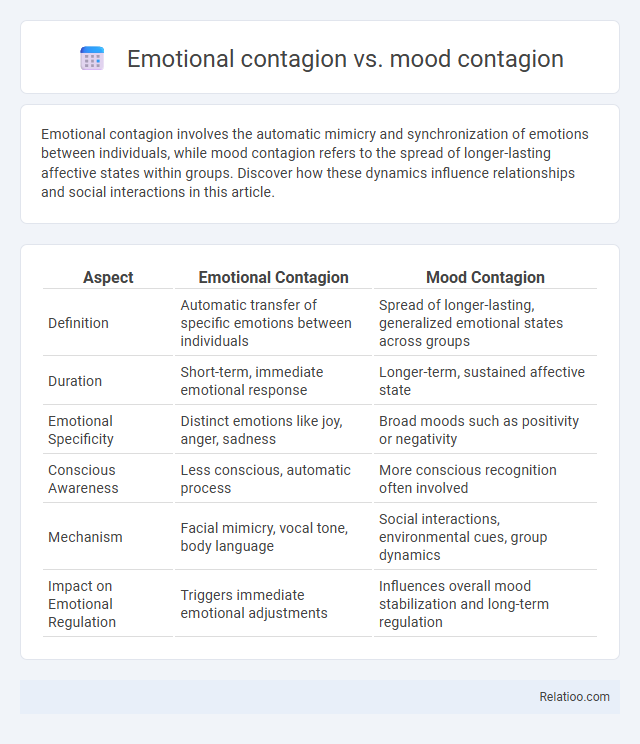Emotional contagion involves the automatic mimicry and synchronization of emotions between individuals, while mood contagion refers to the spread of longer-lasting affective states within groups. Discover how these dynamics influence relationships and social interactions in this article.
Table of Comparison
| Aspect | Emotional Contagion | Mood Contagion |
|---|---|---|
| Definition | Automatic transfer of specific emotions between individuals | Spread of longer-lasting, generalized emotional states across groups |
| Duration | Short-term, immediate emotional response | Longer-term, sustained affective state |
| Emotional Specificity | Distinct emotions like joy, anger, sadness | Broad moods such as positivity or negativity |
| Conscious Awareness | Less conscious, automatic process | More conscious recognition often involved |
| Mechanism | Facial mimicry, vocal tone, body language | Social interactions, environmental cues, group dynamics |
| Impact on Emotional Regulation | Triggers immediate emotional adjustments | Influences overall mood stabilization and long-term regulation |
Understanding Emotional Contagion
Emotional contagion refers to the automatic mimicry and synchronization of expressions, vocalizations, postures, and movements with those of another person, leading to a shared emotional experience. It differs from mood contagion, which involves the spread of a more diffuse, longer-lasting affective state rather than a specific emotion. Understanding emotional contagion is crucial for fields like psychology and organizational behavior as it influences group dynamics, empathy, and social interactions by facilitating emotional alignment and interpersonal connection.
Defining Mood Contagion
Mood contagion refers to the process by which an individual's mood is influenced and altered through exposure to the emotional states of others, often leading to a shared affective experience within a group. Unlike emotional contagion, which involves the automatic mimicry and synchronization of specific emotions like happiness or anger, mood contagion operates on a broader, more diffuse level, impacting overall affective tone rather than discrete emotions. Understanding mood contagion is essential for analyzing group dynamics and the spread of moods in social environments, influencing behaviors, decision-making, and interpersonal interactions.
Key Differences Between Emotional and Mood Contagion
Emotional contagion involves the automatic mimicry and synchronization of another person's emotions, often happening rapidly and unconsciously, while mood contagion refers to the transfer of longer-lasting, less intense affective states between individuals. Emotional contagion typically manifests in specific, short-lived emotions such as happiness or anger, whereas mood contagion influences a person's broader affective tone, like general positivity or negativity over time. The key difference lies in emotional contagion's immediate and specific emotional influence, compared to mood contagion's more gradual and diffuse affective impact.
How Emotional Contagion Occurs
Emotional contagion occurs through nonverbal cues, facial expressions, vocal tone, and body language, which unconsciously influence others' feelings and emotional states. Mirror neurons in the brain play a crucial role by mimicking observed emotions, leading to shared affective experiences. Unlike mood contagion, which involves slower, broader shifts in emotional atmospheres, emotional contagion transmits specific emotions rapidly and directly in social interactions.
Mechanisms Behind Mood Contagion
Mood contagion operates through subtle nonverbal cues such as facial expressions, tone of voice, and body language that influence the emotional states of others in a shared environment. Mirror neurons play a crucial role by enabling individuals to unconsciously mimic and internalize the emotions observed in others, facilitating the spread of mood. Unlike emotional contagion, which often involves specific, intense emotions, mood contagion typically affects broader, more diffuse emotional states over time.
Impact of Emotional Contagion in Social Settings
Emotional contagion significantly influences social settings by facilitating the automatic transfer of emotions between individuals, often through nonverbal cues like facial expressions and tone of voice, impacting group cohesion and collective behavior. Unlike mood contagion, which involves the gradual diffusion of longer-lasting affective states, emotional contagion triggers rapid, momentary emotional responses that can alter interpersonal dynamics and decision-making processes. Understanding emotional contagion is crucial in environments such as workplaces or social gatherings, where shared emotional experiences shape communication patterns and overall group morale.
Mood Contagion in Groups and Workplaces
Mood contagion in groups and workplaces significantly influences collective behavior and productivity by spreading emotional states through nonverbal cues and social interactions. Unlike emotional contagion, which involves sharing discrete emotions like happiness or anger, mood contagion refers to the transmission of broader, longer-lasting affective states such as positivity or negativity. Understanding mood contagion is crucial for leaders aiming to foster a supportive work environment, as it shapes team dynamics, decision-making, and overall organizational climate.
Psychological Theories Explaining Contagion
Psychological theories explaining emotional contagion include the Perception-Action Model, which posits that observing others' emotions automatically triggers mirrored emotional responses through neural mechanisms such as mirror neurons. Mood contagion differs as it involves the transfer of sustained affective states rather than transient emotions, often explained by social appraisal theory where individuals align moods via contextual interpretation. Emotional contagion integrates affective neuroscience and social psychology frameworks, emphasizing unconscious mimicry and feedback processes that facilitate the rapid spread of emotions within groups.
Preventing Negative Contagion Effects
Preventing negative contagion effects involves recognizing that emotional contagion directly transfers specific feelings, mood contagion influences broader emotional states, and affect contagion encompasses both emotions and moods through social interaction. You can mitigate these effects by cultivating emotional awareness, setting boundaries in social environments, and promoting positive communication to reduce the spread of stress, anxiety, or negativity. Implementing mindfulness techniques and encouraging empathetic responses further strengthens resilience against harmful emotional and mood contagions.
Practical Strategies for Managing Contagion
Practical strategies for managing emotional contagion, mood contagion, and affective contagion focus on increasing your emotional awareness and implementing boundaries to protect your well-being. Techniques such as mindfulness meditation, cognitive reframing, and selective exposure to emotional stimuli help you regulate unwanted emotional influences from others. Cultivating empathetic yet controlled interactions promotes resilience, allowing you to maintain emotional equilibrium in both personal and professional environments.

Infographic: Emotional contagion vs Mood contagion
 relatioo.com
relatioo.com